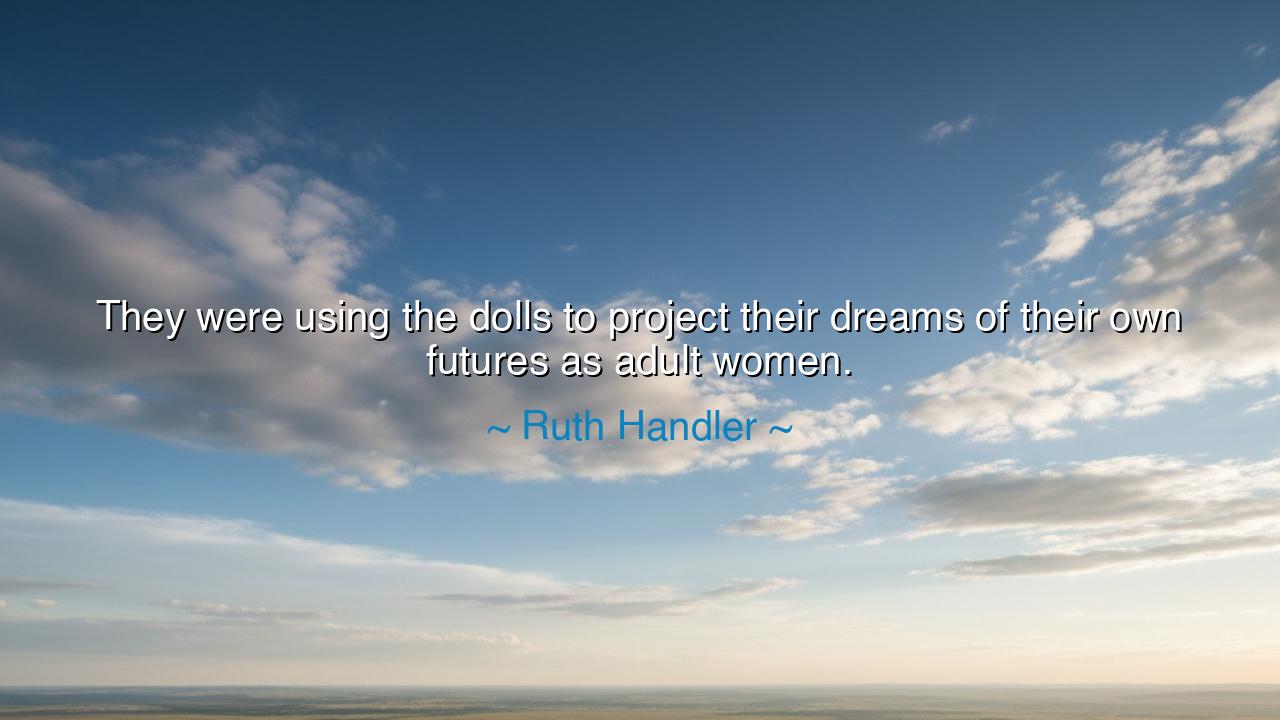
They were using the dolls to project their dreams of their own






When Ruth Handler, the visionary creator of the Barbie doll, spoke the words, “They were using the dolls to project their dreams of their own futures as adult women,” she revealed a truth both tender and profound—the eternal human act of imagination as the seed of destiny. In her simple observation lies the quiet power of childhood, for she understood that the games of the young are not mere play—they are prophecy. The child does not merely mimic the world; she creates it anew, shaping through fantasy the world she hopes one day to inhabit. Handler saw in the hands of little girls not toys, but mirrors—mirrors in which they glimpsed who they might one day become.
To the ancients, this act of projection would have been regarded as sacred. They knew that imagination is the womb of reality, that what the soul envisions with purity and longing, the hands of time will often bring forth. When a child plays, she is a dreamer in training, rehearsing for a future that has not yet taken form. And in that sacred rehearsal, she learns the art of being human—how to love, to nurture, to lead, to build. Ruth Handler, born in an age when women were often confined to narrow roles, sought to give girls a tool not of submission, but of aspiration—a way to dream beyond the walls of their present. Thus, the Barbie doll, to her, was not a figure of vanity, but a vessel of possibility.
Handler’s vision was born from her own observation of her daughter, Barbara, for whom the doll was named. She noticed that Barbara and her friends preferred playing with paper dolls of adult women rather than baby dolls. They did not wish merely to be mothers tending infants; they longed to be women—strong, stylish, capable, independent. They dressed their dolls in imagined careers, romances, and adventures, casting themselves in roles the world had not yet given them permission to play. And in that simple act, Handler recognized a revolution waiting to be born. She saw that through play, the girls were projecting their dreams—and through those projections, shaping the idea of womanhood itself.
History is rich with examples of those who, like these children, dreamed their futures into being. Consider the story of Marie Curie, who as a child in Poland longed to study science at a time when women were forbidden from doing so. She used her imagination as armor, her mind as compass. In her youth, she dreamed of a world where women could explore the mysteries of nature as freely as men—and through her courage and brilliance, she forged that very world. What Handler witnessed in the play of little girls, Curie lived out in the laboratory: the divine power of imagination to transcend limitation and call forth the yet-unrealized.
Handler’s insight was radical because it placed value not on what girls were told to be, but on what they believed they could become. Her doll became a symbol—at times controversial, but undeniably potent—of the modern woman’s self-definition. In its best spirit, Barbie was not about perfection, but about choice. One day, the doll could be a doctor; the next, an astronaut; the next, an artist or leader. Through each transformation, girls were learning a language of empowerment—the understanding that their lives, too, could hold many shapes. They were not fixed in destiny; they were authors of their own story.
Yet, there is a deeper lesson within Handler’s words, one that extends beyond gender or generation. Each of us, whether child or grown, continues to project our dreams into the world, shaping it through vision and intention. What we hold in the theater of our minds will, in time, echo in the architecture of our lives. To imagine freely is not foolishness; it is the highest form of wisdom. The poet dreams, and a new verse of truth is born. The inventor dreams, and a new machine emerges from shadow. The reformer dreams, and the world itself begins to change. Thus, the dream is the first and greatest act of creation.
So let this wisdom be a beacon to all who hear it: honor your imagination. Whether you are shaping a doll, a poem, or a life, know that every vision you hold with love has power. Do not mock your dreams, nor shrink them to please the fearful. For the dream is the map of the soul, and through it, destiny takes shape. Like Ruth Handler, believe in the sacredness of what the young imagine, and protect the fires of wonder in your own heart.
For in every dream—no matter how small, no matter how fanciful—there lies the seed of a new world waiting to be born. And as Handler saw in the hands of children, so too may we see in ourselves: that to dream is to become, and to imagine without limit is to walk in step with creation itself.






AAdministratorAdministrator
Welcome, honored guests. Please leave a comment, we will respond soon